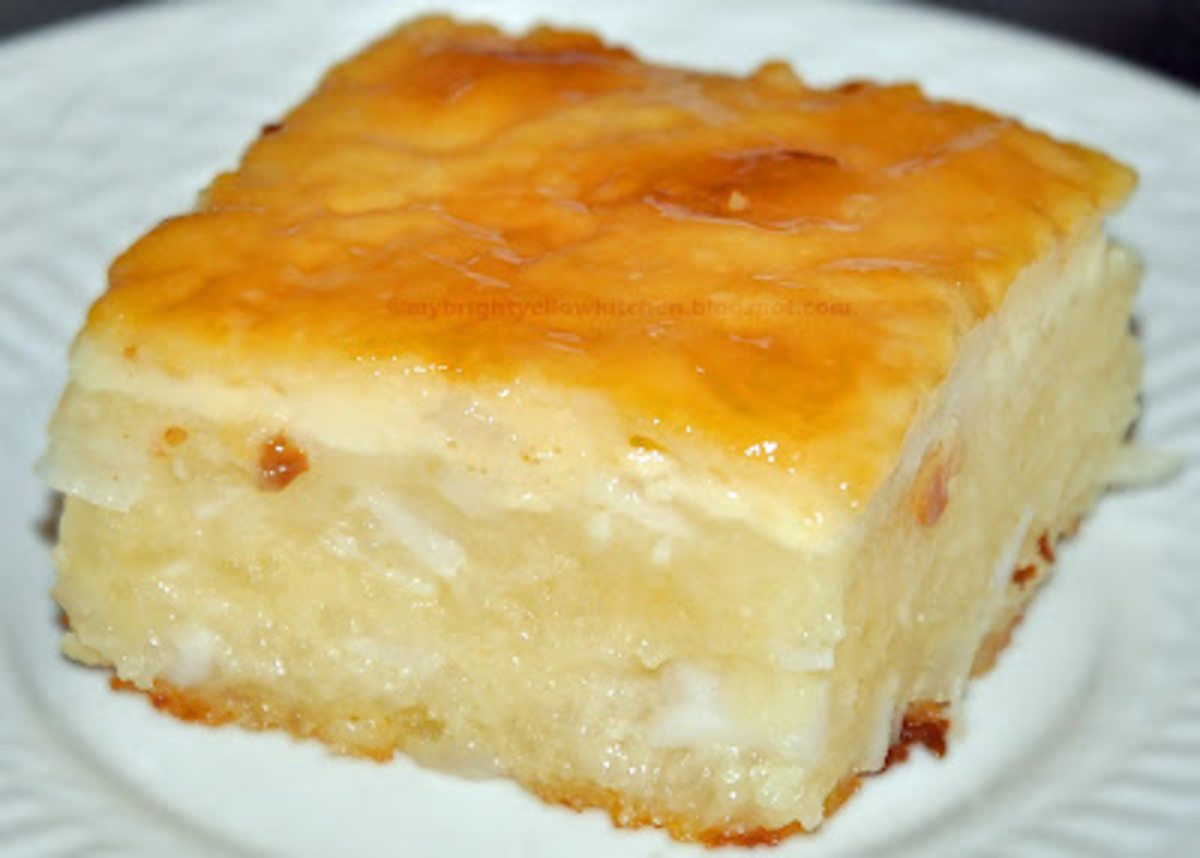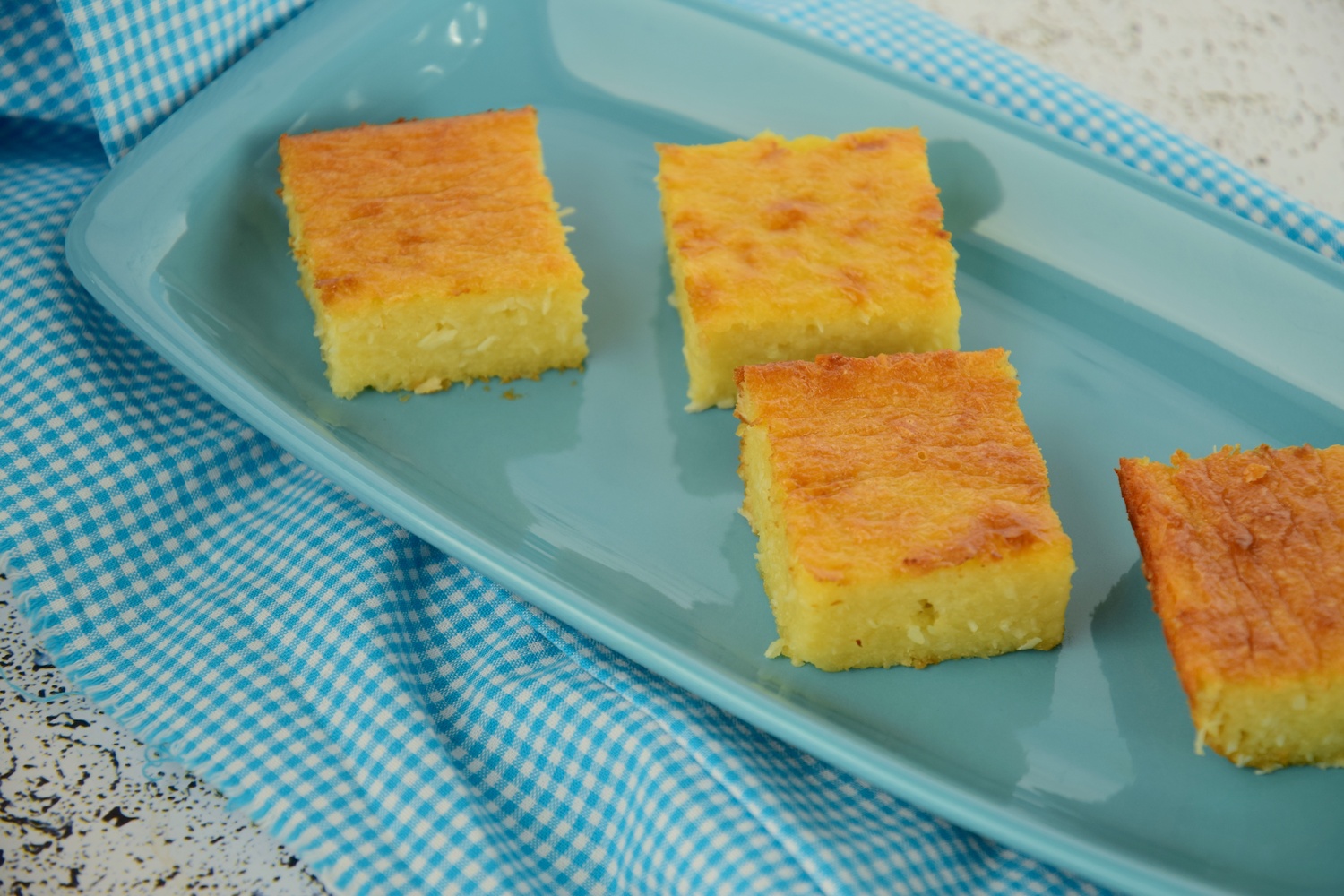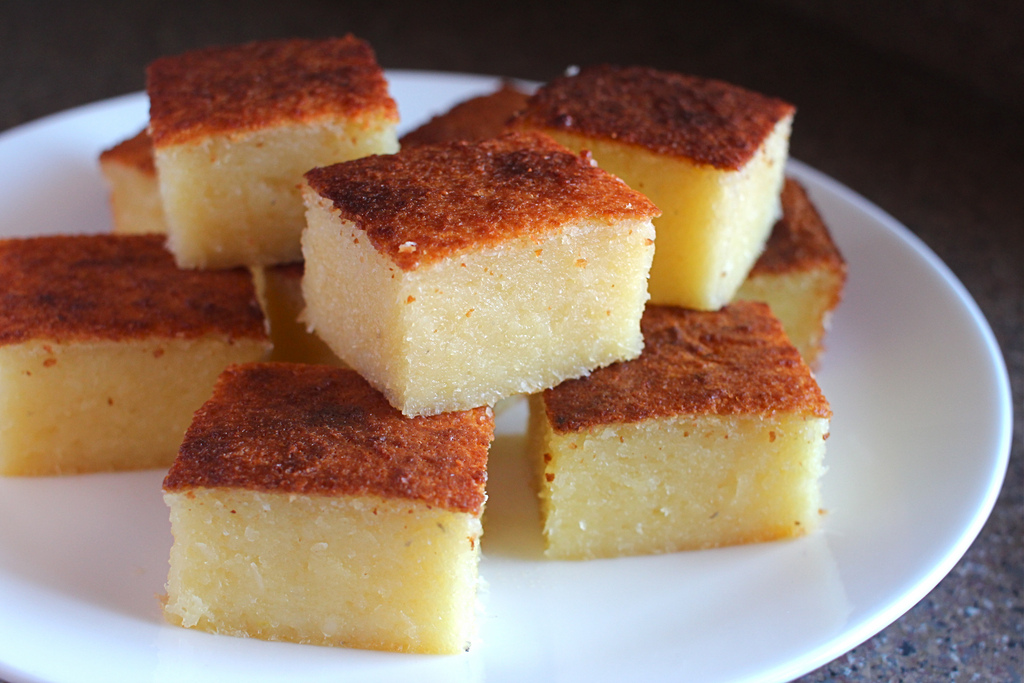Cassava Cake is a classic Filipino dessert made from grated cassava (manioc). Cassava is also known as among kahoy and balinghoy in the Philippines. Cassava starch is also used to make tapioca. There are different cassava cakes around, but this Cassava Cake Recipe is by far, the best that I have had.

This cassava cake recipe is my personal favorite. It is not until the time when I came here to the US that I was able to try the best cassava cake. I wish that was exaggerating, but I am not. This cassava cake recipe is really great because it tastes good, it is rich and very easy to prepare. The credit goes to our good friend, Sharon, who was kind enough to share her cassava cake recipe with us. So I asked for her permission to share the recipe with you, and she agreed. So here we are now with this Cassava Cake Recipe for everyone’s enjoyment.
What is Cassava Cake?
One of the most delightful aspects of every meal is, without question, the scrumptious dessert that ends it. Cassava cake is one of my absolute favorite desserts, as it’s not only trademarked Filipino but also incredibly delicious. The perfect blend of cheesy, buttery, and nutty, this cake melts in your mouth, letting you fully enjoy the harmonious intermingling of flavors. It’s a delightful and hearty way to finish up a fantastic meal –– and one you can bring to potlucks, too!
With Latin American roots, cassava was first introduced to the Philippines sometime in the 16th century. Many also point out that this dish was a native of Lucban, Quezon. Other names this dessert goes by include:

- cassava pudding, cassava pie, cassava bibingka
- bibingkang kamoteng kahoy
- bibingkang balanghoy, and
- Budin
However, you call it, though, the description of this wonderful dessert remains the same. The mix of cassava, milk, egg whites, and cheese produce a cake that is chewy and somewhat firm in nature but still manages to soften in your mouth.
And what is cassava?
You may be surprised to find out that this sweet and decadent dessert actually stems from a root crop, not unlike sweet potatoes or yams! Cassava is a rich and affordable carb that has found a home in many cuisines across the entire world. In fact, more than 80 countries are proud to call cassava their natives, growing in countries that are mostly tropical in climate.
However, it’s important to note that you should never eat cassava raw. Without cooking it thoroughly, the plant contains traces of cyanide, which may be dangerous to your health. Cassava is great for withstanding volatile temperatures and climates but is also quite susceptible to many infections.
Baking and boiling are the most common ways of enjoying this tasty vegetable. But apart from those ways, and the yummy cassava cake, here are other things you can make from this root crop:
Cassava Bread
Whether you’re using cassava flour only or a mix of both cassava and wheat flour, making your own bread is a somewhat long but worthwhile experience. If you opt for the former, this bread is inherently gluten-free, nut-free, and Paleo diet-friendly. It can also be yeast and dairy-free (although not vegan). Like cassava cake, bread is a wonderful thing to make at home. Additionally, you can even turn this into a fun family activity for everyone.

Cassava French Fries or Wedges
Cassava isn’t just good for sweet treats like cassava cake. For instance: who doesn’t love french fries? Whether you’re snacking on them on your own or with a sandwich or burger, they’re definitely a nice treat to fill you up. By substituting your usual potatoes with cassava, you have fries or wedges that are not only healthier but taste just as, or even more delicious! You can choose to deep fry them or bake them, but either way, you can enjoy these goodies with ketchup on the side.
Mashed Cassava
If you’re a fan of mashed potatoes, then you will also enjoy this mashed cassava! While a far cry from the sweet cassava cake, this savory side will fill you up as well as any cup of rice or plate of noodles can. Mashed cassava works, as well as mashed potatoes with a nice heaping gravy, poured all over it. I enjoy this mashed cassava with meat dishes like steak or pork chops, as well as a lovely crispy fried chicken. Eaters young and old will really enjoy this dish!
Tapioca
Lastly, tapioca is another way of enjoying this classic crop in a sweet way, apart from our beloved cassava cake. Tapioca is a starch you can get from the roots of the cassava plant. Thick and gelatinous in texture, tapioca is popular as chips or even jelly. Tapioca pudding is a popular option in many Southeast Asian countries –– a lot like sticky rice pudding. And of course, if you are a boba tea fan, tapioca pearls are an absolute staple. You can’t call boba tea boba tea without them!
With the many ways you can enjoy cassava, there’s really something in this root crop that’s for everyone –- cassava cake included! What’s your favorite way of enjoying cassava?
What are cassava’s health benefits?
As we mentioned earlier, cassava is a hearty and healthy alternative to the many different carbohydrates we consume daily. While cassava cake is a deliciously sweet and indulgent treat, it is also, surprisingly, quite a healthy one! But what about this crop makes it so nutritious?
Its being rich in fiber means that it does wonders for your digestive health as well! Having enough starch and fiber in your system helps your metabolism and digestive system run at an optimal speed. With all these health benefits we’ve mentioned, you’ll definitely find it difficult to pass on a delicious cassava cake now!
What is the difference between cassava cake and bibingka?
As we mentioned earlier, some also refer to this tasty treat as cassava bibingka. This is because the recipe for cassava cake and another Filipino classic, bibingka, are incredibly similar, saving the key ingredients in each dish. To be more specific, the former uses cassava, of course, while the other’s main element is malagkit or glutinous rice.
Another difference between these two desserts is the fact that bibingka is traditionally baked in banana leaves. This has a softer texture when you compare it to cassava cake, which is spongier and cakier.
However, whichever dessert you prefer more, you can’t deny that both of them pair perfectly with a nice hot cup of coffee or cocoa.
Variations on Cassava Cake
As we mentioned earlier, making cassava cake can be divided into two parts: making the batter, and then the toppings. It is, to be honest, a pretty straightforward recipe.
But did you know there are many different ways you can put a spin on this classic dish? For this recipe, I have already included the classic, yummy cheddar cheese on top. But some people add macapuno strings or even grated coconut to give it that added depth of flavor. There’s also a variant called pineapple cassava cake, where people add pineapple chunks to the batter and topping! This unique tropical flavor is a refreshing twist on your favorite Filipino dessert.
Moist is better
You can also adjust how thick or soft you want your cassava cake to be, by how much cassava you put in it! For this recipe, we use 2 packs of grated cassava, about 2 lbs. in weight. However, if you want to make your cake a little on the moister side, you can use less. If you want it firmer, then opt for more. But in my opinion, 2 lbs. strikes the right balance between a soft cassava cake and a gelatinous pudding.
The topping matters
Lastly, another way you can make your cassava cake different according to your liking is how thick you want your topping layer to be. For some people, the cassava cake topping is as thick as the actual batter. Others use a milk-based or coconut-based topping, while some opt for no topping at all! It truly is up to you and how you enjoy this delightful dessert.
Even regionally, cassava cakes can differ in both ingredients and preparation. For example, Vigan is home to another classic delicacy called royal bibingka. Don’t be fooled by its name, though; this dish is essentially the cassava cake we know and love, except in cupcake form! Topped with cheese and margarine, it’s another sweet and indulgent treat you’ll be wanting seconds (and thirds) of!
Other Filipino Desserts to Enjoy
If you liked making this cassava cake, you may enjoy these other recipes, too! Cassava cake is delicious, but it’s only one of the many wonderful Filipino desserts that make our cuisine so unique.
Leche Flan
It is rare to come across a Filipino who hasn’t heard of, or doesn’t enjoy a good leche flan. A fan favorite of many (like cassava cake!), leche flan consists of eggs, milk, and a delightful caramel coating. Filipinos undeniably have a sweet tooth –– and you can’t get any sweeter than this! A dinner party, celebration, or holiday season just isn’t complete without this wonderfully decadent delight. Not only is it super delicious, but it’s simple to make! In no time at all, you’ll get to have your fill of your favorite.
Bibingka Muffins
When the holiday season is right around the corner, stalls selling cassava cake, bibingka, and other sweet treats line the streets, especially near chapels. Christmas markets are the best place to find not only your classic favorites, but new and innovative variations from different home cooks. These bibingka muffins are an example of something old that you can make gold from the comfort of your own home! These goods may be bite sized, but they’re still full of the flavor you love. And like a slice of cassava cake, you won’t be satisfied with just one!
How to Cook Cassava Cake
This recipe for cassava cake consists of two (2) processes. The first is making the cassava batter, and the second is preparing the topping.
Making the batter
Let’s start with the batter. Combine the grated cassava, butter, milk, a portion of the cheese, sugar, eggs, and coconut milk in a mixing bowl. Use a wire whisk to mix all the ingredients together. This step will only take a couple of minutes to complete.
Baking the cake
You will need to grab a baking pan and grease it with oil. You can simply spray cooking oil such as Pam, or you can pour around 1 teaspoon of oil and spread it using your fingers. Pour the cassava mixture to the baking pan. At this point, the oven should have been preheated.
Bake the cassava cake until done. While waiting, you can start preparing the topping. This is a simple process, simply mix all the topping ingredients as seen in the recipe below and cook until the texture gets thick. Once the cassava cake is done baking, pour the topping over and spread. Top with extra cheese and bake again for a few minutes until the top gets nice and brown.
Try this Cassava Cake Recipe. Enjoy!
Cassava Cake
Ingredients
- 2 packs of grated cassava about 2 lbs total weight
- 2 cups coconut milk
- 1/2 12 oz. can evaporate milk
- 3 pieces egg
- 1/4 cup butter melted
- 6 tablespoons cheddar cheese grated
- 1/2 cup condensed milk
- 14 tablespoons granulated white sugar
Topping ingredients:
- 2 tablespoons flour
- 2 tablespoons sugar
- 1/2 cup condensed milk
- 2 tablespoons cheddar cheese grated
- 2 cups coconut milk
Instructions
-
Make the batter by combining the grated cassava, butter, 1/2 cup condensed milk, 1/2 cup evaporated milk, 6 tablespoons cheddar cheese, 14 tablespoons sugar, and 2 eggs in a mixing bowl and mix thoroughly.
-
Add the 2 cups of coconut milk to the mixing bowl where the mixed ingredients are. Mix again.
-
Grease the baking tray then pour in the batter (these are the ingredients that you just mixed together).
-
Preheat the oven to 350 degrees Fahrenheit for 10 minutes then put in the baking tray with butter and bake for 1 hour. Remove from the oven and set aside.
-
Meanwhile, prepare the topping by combining 2 tablespoons of sugar and flour in the heated saucepan.
-
Pour in 1/2 cup condensed milk then mix thoroughly.
-
Add 2 tablespoons of cheddar cheese while stirring constantly.
-
Pour 2 cups of coconut milk and stir constantly for 10 minutes
-
Pour the topping over the Cassava Cake (baked batter) and spread evenly.
-
Separate the yolk from the egg white of the remaining egg (we’ll be needing the egg white only)
-
Glaze the topping with the egg white using a basting brush. Simply dip the brush into the egg white and brush it on the cassava cake.
-
Set your oven to broil mode. Broil the Cassava cake until the color turns light brown.
-
Garnish with extra grated cheese on top. Serve. Share and enjoy!
 ZiddiDil.Com ZiddiDil.Com – Watch Hindi Desi TV Serials Episode Online
ZiddiDil.Com ZiddiDil.Com – Watch Hindi Desi TV Serials Episode Online


